This January and February, we’ll be finishing up our look at the second season of Star Trek: The Next Generation and moving on to the third year of the show, both recently and lovingly remastered for high definition. Check back daily for the latest review.
Contagion is a nice reminder that the average quality of Star Trek: The Next Generation is improving. While the stand-out episodes of the second season of The Next Generation tend to attract a lot of attention, the more solid episodes tend to get a bit lost in the discussion. Contagion doesn’t rank alongside Elementary, Dear Data, A Matter of Honour, The Measure of a Man or Q Who?, but it’s still demonstrating that we’ve reached a point where the show can churn out a pretty good episode without it feeling like a special occasion.
It’s a bit of a shame, then, that Contagion comes from two individuals outside the show’s writers’ room.
The writers room is a very interesting place. There are a lot of different ways to produce television, and they each have their own strengths and weaknesses. Modern television, for example, tends towards the “showrunner” model. Big producers or writers will very carefully and meticulously craft the structure and identity of their show. This model is quite popular in Britain, where reduced episode counts make it feasible for individual writers to produce whole seasons of television.
It is increasingly common in the States. For example, Aaron Sorkin had a writing credit on almost every episode of The West Wing broadcast during the show’s first four seasons. However, it’s not necessary do that much writing to be a clear guiding light for a show. David Simon is very clearly a guiding showrunner on the HBO series that he has produced, often producing impressive supplemental reading material. Joss Whedon very clearly brands his own stamp on his shows, with even Agents of S.H.I.E.L.D. being managed on a day-to-day basis by his brother and his sister-in-law.
While the “showrunner” has become more and more popular in the age of prestige television, the writers’ room is an institution that remains vitally important. Drawing on a regular staff of writer employed to work on the show, the writers’ room is a community that helps give a television show its unique voice and perspective. In some cases, the room itself has one collective voice, like some well-tuned chorus; in other cases, distinct voices can be clearly discerned.
Part of the evolution of The Next Generation from a muddled and disjointed science-fiction spin-off into one of the most respected shows on television was the careful maintenance and development of a phenomenal writers’ room. From the third season onwards, the show had a reliable contingent of talented writers including Brannon Braga, Ronald D. Moore, René Echeverra, Naren Shankar and Ira Steven Behr, among others. Michael Piller (and later Jeri Taylor) helped to shape and guide that room.
Part of the problem with the first and second seasons of The Next Generation is that there’s no attempt to develop and expand the show’s writers’ room. Often, it seems like the writers were at odds with one another; to say nothing of the awkward relationship that existed with Gene Roddenberry. Two of the stronger forces in the early Next Generation writers’ room seemed to be locked in conflict. Tracy Tormé was writing ambitious scripts that often felt like they were so subversive they’d been put through a shredder on the way to screen; Maurice Hurley was much more safe and traditional.
Outside of that, though, there was no sense that the show was trying to develop or train any of its writers. Instead, most of first two seasons seemed to be the product of writers passing through. Occasionally individuals like Richard Manning and Hans Beimler might make an impression, but they were the exception rather than the rule. Melinda Snodgrass had to submit The Measure of a Man in order to get picked up and recruited by the show.
Contagion is the perfect example of an episode that The Next Generation should be encouraging at this point in its run. It’s the work of two outsiders bringing their ideas to the franchise. Beth Woods happened to be a fan of the show who was working on the office computers. Her filmography remains relatively sparse, which is a shame. There’s a lot of obvious talent involved in putting together something like Contagion.
In contrast to Woods’ lack of experience, her co-writer, Steve Gerber, had an impressive selection of credits across a variety of media. He would write for popular shows like Batman: The Animated Series, and had a popular and acclaimed career in American comics. His most high-profile work was defining Marvel’s Man-Thing and as the creator of Howard the Duck, one of the first Marvel properties to transaction to a high-profile film. Gerber is an unsung hero of American comic books, and The Next Generation would have been lucky to have him as a regular contributor.
However, neither Woods nor Gerber were part of the regular rotation of staff writers on the show, either before or after Contagion aired. At this point in its life, The Next Generation needed a lot more of these sorts of writers pitching these sorts of ideas. Something to stablise the show between the relatively safe and old-fashioned work of Maurice Hurley and the more bold and experimental output of Tormé.
Indeed, this is ultimately what helped stabilise the show. During the third season, Michael Piller and Jeri Taylor worked hard to develop a bunch of young and inexperienced writers, allowing them to help set the course and define the identity of the show. Ronald Moore was an impressive writer when he joined The Next Generation; by the end of his first year he was a phenomenal talent. The same is true of Rene Echevarria.
However, despite the fact that Contagion worked out pretty well, neither Woods nor Gerber ever contributed to another episode. Gerber himself has talked about his disappointment with how the episode turned out:
Beth and I worked directly with Gene Roddenberry on that episode. Let’s just say that after we finished Contagion, I didn’t want to do another one. (Beth did a write at least one more episode, I believe.) I liked Gene tremendously as a person. Beth and I had dinner at his home one evening, and besides discussing our script, we spent a couple of hours swapping stories about his battle with Paramount over Star Trek and mine with Marvel over the duck. We had a long talk about show biz in general, about politics, religion — you name it. It was a very memorable evening. As a producer, though, Gene drove me completely nuts. Beth and I must’ve done about six or seven drafts of the Contagion script, and it really didn’t get any better — just different – after about the third or fourth. It got to the point that Gene was asking for changes just for the sake of making changes. It was his show, of course, and he had every right to do it his way, but I can’t work like that. It was a case of two very independent thinkers whose thinking didn’t mesh.
Woods went on to write the script Our Brother’s Keeper, which served as part of the basis for Ronald D. Moore’s Sins of Our Father in the third season. Gerber never wrote for Star Trek again. Which is a shame.
Contagion is, on the surface, a fairly standard episode. However, it’s a fairly standard episode that manages to be solidly entertaining without exerting too much effort. This is really just an example of the quality towards which an average episode of The Next Generation could comfortably be aiming. This isn’t an episode that tries too hard or redefines a paradigm. It’s just a fun adventure on its own terms.
What is striking, however, is how far above the average quality of the episodes that have aired to date. Contagion isn’t the best episode of The Next Generation produced at this point in the show’s run, but it lands somewhere near the top by default. It’s great to have exceptional stand-out episodes that redefine the show, but it’s also important to have some measure of consistency – particularly for a show that is largely episodic.
And, despite the episodic nature of The Next Generation, Contagion does a fair amount of world-building. Most Star Trek fans can tell you that this is the first time that Picard utters the phrase “tea, Earl Grey, hot” to the replicator. It is also the first indication of Picard’s fascination with archaeology – something that would become one of the character’s defining traits. “Archaeology has been a hobby since Academy days.”
It also confirms that the relationship between the Romulans and the Federation is fraught with tension. This was made rather clear in the first episode of The Next Generation to feature an appearance from the Romulans, The Neutral Zone, and has been a recurring thread. It was implied by the mentions of the Romulans in Angel One and The Measure of a Man. However, Contagion is only the second appearance of the Romulans in The Next Generation, ans the show immediately depicts the Federation locked in a Cold War with those enigmatic aliens.
Explaining his desperate race to find Iconia, Captain Varley argues, “The risk would be in allowing the Romulans to locate Iconia. Fortunately, I got there first. It’s a virtually dead planet, but enough technology remains to give the Romulans an edge if they should find it.” There’s a sense that the Romulans are building towards a conflict with the Federation – which is really only the second time that interstellar war has really been alluded to in The Next Generation. (The first was when Picard considered the ramifications of messing up the confrontation of the Romulans in The Neutral Zone.)
Of course, at this point in the show’s run, the Romulans are the only species that really allow for such a threat. The Klingons are now allies and the Ferengi have been largely defined as independent scavengers. There would be other major interstellar governments established later in the run of The Next Generation, most notably the Cardassians, but – for now at least – the Romulans are characterised a hostile government and political adversary.
It’s worth remarking just how much this set-up feels like a classic Star Trek episode. After all, the Cold War was well on the way to winding down in the late eighties. Peace with the Klingons was the franchise’s way of dealing with détente. So having the Federation spend most of the twenty-fourth century locked in a Cold War with the Romulans feels like a rather dated metaphor. The Federation’s relationship with the Romulans feels like a conscious throwback to sixties politics. The plot thread even allows for an extended homage to The Manchurian Candidate in Mind’s Eye during the show’s fourth season.
The revival of the Cold War metaphor isn’t the only nostalgic touch in Contagion. The plot centres around one of those long-dead advanced civilisations that were quite popular in the early days of the original Star Trek, with an archeological dig unearthing more than just fossils. “Well,” Varley explains, “I had heard rumours about a couple of archaeological digs that started making the Iconians sound a lot less like legend. I did a little investigating, and I located their homeworld.”
Although the Iconians are only referenced in one further episode of the franchise, they clearly belong alongside the “Old Ones” of Exo III and the monsters stalking M-113. They are even referred to in vaguely mystical terms as “demons of air and darkness”, creating the impression that the Iconians are a suitably Lovecraftian alien civilisation. “Legend has it that they travelled without the benefit of spaceships, merely appearing out of thin air on distant planets.”
Of course, there’s inevitably a scientific explanation. After all, advanced technology is indistinguishable from magic. Even Picard argues as much when Wesley raises the issue. “Well, we would appear magical to Stone Age people,” he assures the young lad. We discover the technology that the Iconians used to build their empire; another graveyard world, a relic left over from a more primal stage of the universe’s development. This is something that the original Star Trek did very well in it first season – creating the sense that Earth was a very late developer on the cosmic stage.
Indeed, Contagion is notable for thrusting Picard into the action. Unlike the original Star Trek, The Next Generation has fairly consistently avoided having the captain lead away missions. The reasons for this are quite obvious – Kirk’s insistence on abandoning his command borders on the reckless. Here, Picard decides the lead team himself, making Contagion feel rather consciously like a throwback to classic Star Trek. “I’ll arrange an away team,” Riker boasts. “And I’ll lead it,” Picard replies.
Varley himself also fits the mold of the rogue captain from the classic Star Trek show. Later spin-offs tended to favour obstructive admirals meddling with the crew, but Kirk seemed to stumble quite frequently across Starfleet commanders who had decided to go off the reservation for their own reasons – consider Garth of Izar in Who the Gods Destroy or Captain Tracey in The Omega Directive or even R.M. Merik in Bread and Circuses.
Varley takes it on his own back to violate the Neutral Zone and risk starting a war with the Romulans. His logs suggest he did this against the wishes of the crew, infected with a sort of zealotry. “My First Officer is questioning the wisdom of my order to violate the Neutral Zone, but I am convinced that I have taken the only proper course. Should this advanced technology fall into the hands of the Romulans, we might as well dock our ships and defend ourselves with sticks.” It’s worth noting, though, that Contagion is far more sympathetic to Varley than to most of the rogue commanders Kirk encountered.
The second season of The Next Generation has seen the writers trying to figure out how best to emulate the classic show. It isn’t as simple as copying and pasting certain plots and characters across the decades. It’s more than simply introducing Pulaski as a stand-in for McCoy. Like The Measure of a Man before it, Contagion finds a way to update many of these tropes and storytelling concepts so they can work within the context of eighties television. It’s not about literal references so much as trying to evoke a particular mood.
The other interesting aspect of Contagion is the way that it is built around a computer virus. This isn’t anything too strange. Woods was a computer technician, and computer viruses were beginning to really enter public consciousness at the end of the eighties. In particular, a number of high-profile examples in the late eighties had attracted headlines and news coverage. Part of this was due to epidemics of increasingly devastating computer viruses.
Brain ran wild in 1986, released as an unintended side effect of attempts by Basit and Amjad Farooq Alvi to protect their medical software. In 1987 and 1988, the Jerusalem virus caused a minor panic, deleting all files on infected computers on Friday the 13th. Around that same time, the Byte Bandit was developed as an extremely destructive virus. Mid-1988 saw the release of CyberAIDS and Festering Hate upon the world. As such, a Star Trek episode about a deadly computer virus seems quite timely.
However, it’s notable that Contagion is really on the latest example of the Enterprise itself becoming “infected” by a foreign organism. Episodes like Home Soil and A Matter of Honour also featured the invasion of the ship by non-humanoid alien entities. In BFI’s Star Trek, Ina Rae Hark suggests this fascination with infection and corruption reflects another concern of the time:
Nanites Wesley modified as a science experiment evolve and infest the ship’s systems in ‘Evolution’; Data’s puzzling dreams, when decoded, reveal that interphasic parasites are eating away the cellular peptides in the makeup of both ship and crew in ‘Phantasms.’ A virulent space bacterium starts eroding the hulls of the Enterprise and a Klingon vessel on which Riker is serving as part of a cultural exchange in ‘A Matter of Honor.’ The emphasis on disease-like organisms infecting systems or eating through exteriors may reflect TNG’s initial broadcasts during the height of the AIDS epidemic, although in each case the infections first get into starships and not into bodies. (Even the provocatively titled ‘Contagion’ is about a computer virus and not a pathogen.)
It’s not too far-fetched at all. Indeed, one of the most significant failings of the Star Trek shows in the eighties and nineties was an unwillingness to deal directly with important social issues like the spread and prejudice surrounding AIDS. Writer David Gerrald famously wrote an episode around the issue – Blood and Fire – that never made it to air. It wasn’t until UPN decided to make AIDS awareness a focal point of their 2002 and 2003 season that Star Trek: Enterprise produced Fusion.
So The Next Generation seemed fixated on the idea of infectious organisms attacking the ship itself. To be fair, as Jessica R. Johnston argues in Technological Turf Wars: A Case Study of the Computer Antivirus Industry, this use of computer virus imagery to tackle more biological fears is quite widespread:
In many of these popular culture texts, representations of the body/machine interface display fears about the penetration of technology – the humans become appendages of it rather than its master; that they cannot resist it; that technology negatively changes their lvies forever; that they serve technology, rather than the reverse; that technologies are fast outstripping human abilities. Those fears are also attributed to the technology itself – as a source of power, as potentially destructive, as changing fundamentally the understanding of ‘human.’
This anxiety towards technology operates with a wider, general social climate of unease that is fuelled by the contemporary prominence of a number of biological infections: AIDS, Ebola, severe acute respiratory syndrome (SARS), and avian flu. The biological virus is seen as a parasitic organism, invading and damaging the body’s cells while using those cells to replicate its own form. Similarly, the computer virus is self-replicating code capable of transforming files or other programs on a computer and spreading itself throughout the network.
It’s still a bit of a cop-out, with The Next Generation unwilling to tackle the issue directly. Still, it explains the show’s fixation with infections of the Enterprise, placing them in a wider social and pop culture context.

Also, I love how the Romulan bridge is very clearly modelled on the layout of the classic Enterprise…
Contagion also makes fairly good use of the ensemble. Picard gets to go into action. Riker gets some great lines. (“In case it should become necessary to fight, could you arrange to find me some rocks to throw at them?” he asks as the Enterprise’s systems fail during a stand-off with the Romulans.) Data gets to be effective comic relief. Geordi even gets an action sequence as he tries to rush to the bridge in order to save the ship from eminent disaster.
Considering the difficulties demonstrated by the character in The Dauphin, it’s worth noting that Contagion manages to find a use for Wesley. The boy wonder gets a lovely little sequence where he discusses the risks inherent in space travel with Captain Picard. It’s one of the stronger uses of Wesley to date, underscoring the vaguely paternal relationship that exists between Wesley and Picard. It also suggests the sorts of existential realities that would confront a teenager on a ship like the Enterprise. He could die out there in an instant, due to some quirk or phenomena or extraterrestrial object. That has to be terrifying.
At the same time, Gerber and Woods really struggle to figure out what they are supposed to be doing with Deanna Troi. Troi has always been a bit of a troubled character on The Next Generation, and she doesn’t ever really settle into a role in the ensemble. The notion of a counselor serving as a member of the senior staff was always going to be hard to get right. The fact that Whoopi Goldberg’s Guinan has effectively usurped what should be Troi’s role in the ensemble – and seems to be doing that job better than Troi ever did – doesn’t do the character any favours.
So Troi winds up as the character who sits on the bridge and tells Picard that the enemy ship that is firing on them is projecting feelings of “aggression.” At least, while she’s waiting for the creepy romantic plot line of the year to hit her. Contagion sort of acknowledges that Troi really isn’t that useful on the bridge of the Enterprise. When Riker sends her elsewhere, she protests, “But you might need me if you have to negotiate with Taris again.” Riker simply responds, “I’ll manage.”
Contagion isn’t perfect. It leans a little bit too heavily on standard Star Trek clichés. However, that’s also part of the fun. It’s the first time that The Next Generation has felt entirely comfortable while channeling the storytelling and narrative tools of classic Star Trek. It’s not an exemplary stand-out episode, but it’s well-constructed and demonstrates that it really shouldn’t be so hard to produce a quality hour of The Next Generation.
We haven’t reached the point where the show is consistently this good, but Contagion sets a reassuring target for what should be the show’s baseline of quality. And that’s a very good thing.
Read our reviews of the second season of Star Trek: The Next Generation:
- The Child
- Supplemental: Phase II (1978) – The Child
- Where Silence Has Lease
- Elementary, Dear Data
- Supplemental: Embrace the Wolf
- The Outrageous Okona
- Loud as a Whisper
- The Schizoid Man
- Unnatural Selection
- Supplemental: Deep Space Nine (Marvel Comics) #3-4 – The Cancer Within
- A Matter of Honour
- The Measure of a Man
- Supplemental: Myriad Universes – Echoes and Refractions: Brave New World by Chris Roberson
- Supplemental: The Measure of a Man (Extended Cut)
- The Dauphin
- Supplemental: Masks by John Vornholt
- Contagion
- The Royale
- Time Squared
- The Icarus Factor
- Supplemental: The Lost Era – Deny Thy Father by Jeff Mariotte
- Supplemental: (DC Comics) Annual #2 – Thin Ice
- Pen Pals
- Q Who?
- Samaritan Snare
- Up the Long Ladder
- Manhunt
- The Emissary
- Peak Performance
- Shades of Grey
Filed under: The Next Generation | Tagged: Cold War, Contagion, gene roddenberry, history, Iconia, jean-luc picard, Klingon, List of Star Trek characters (N–S), marvel, Matter of Honor, Michael Piller, Neutral Zone, Next Generation, Romulan, ronald d. moore, star trek, star trek: the next generation, StarTrek, Steve Gerber, United States, William Riker |
















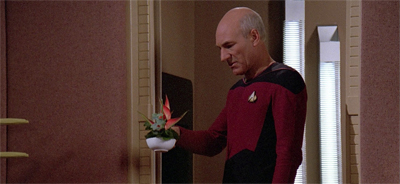
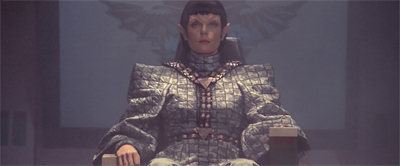

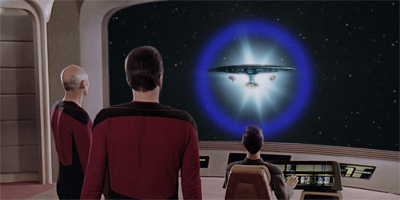


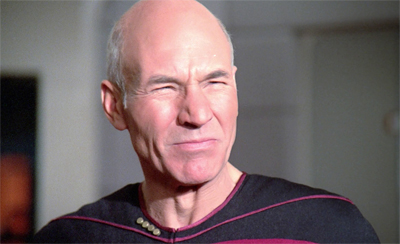


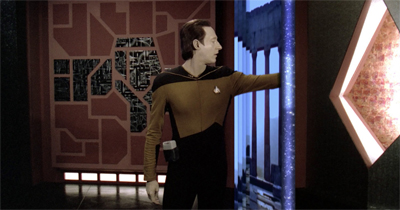
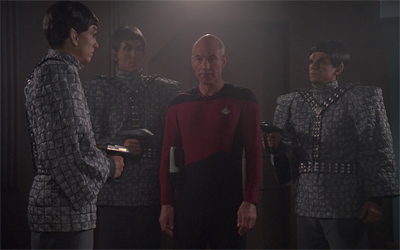




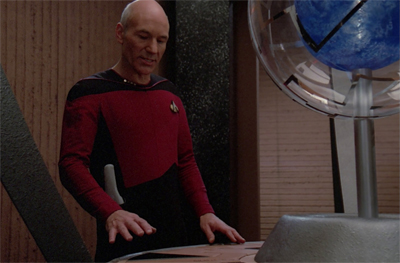
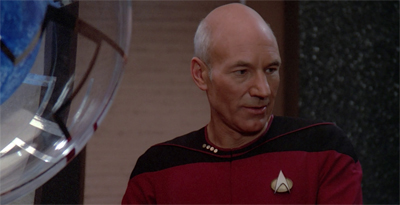





This is one of my favorites in the second season. The mixture of ominous Lovecraftian undertones and the wonderfully abstract rendition of Clarke’s third law reminds me of the particular vision of Richard Kelly, a personal fave. It’s either really great or a big missed opportunity that the Iconians are so sparingly discussed.
Massively underrated as Next Generation episodes go.